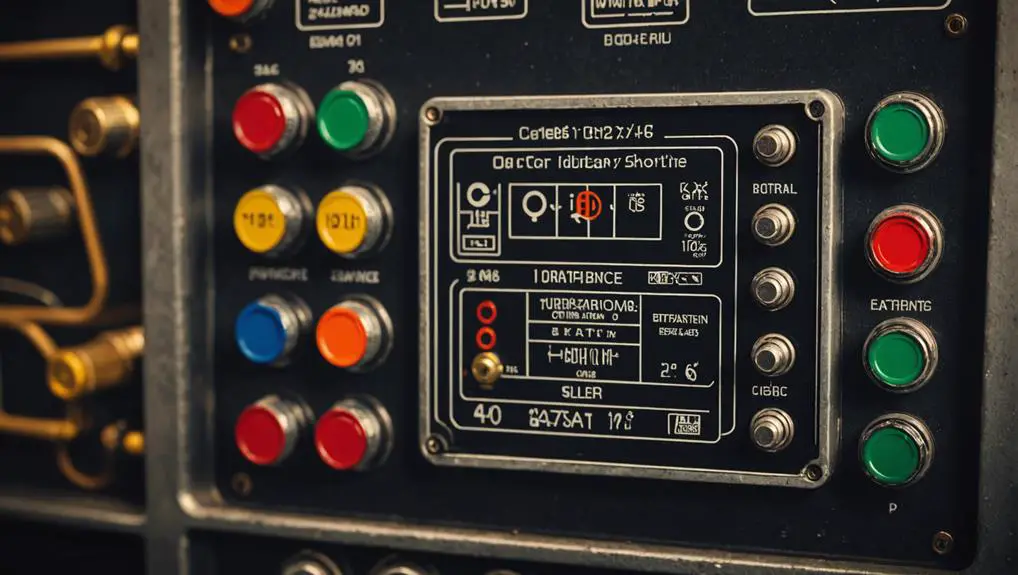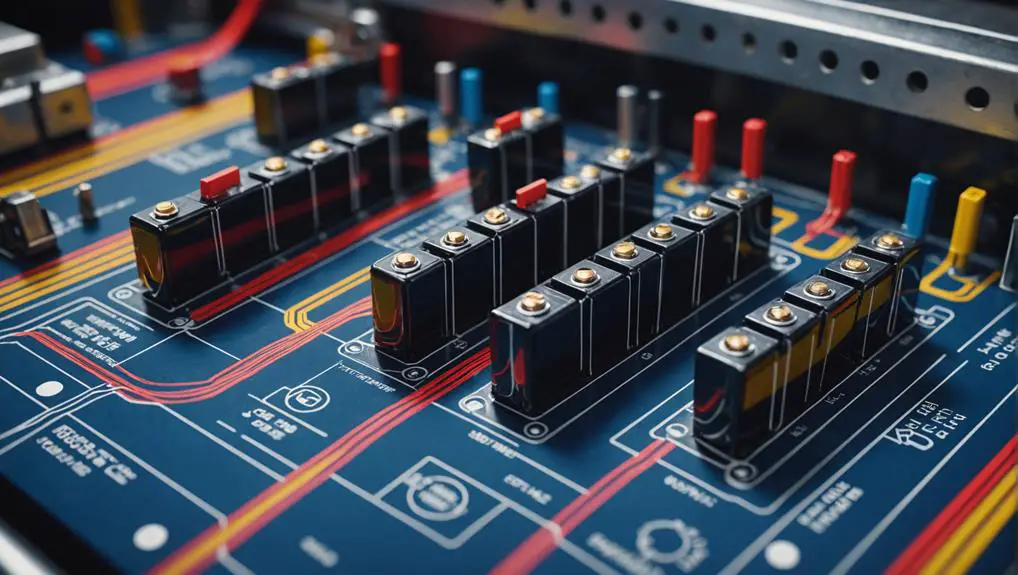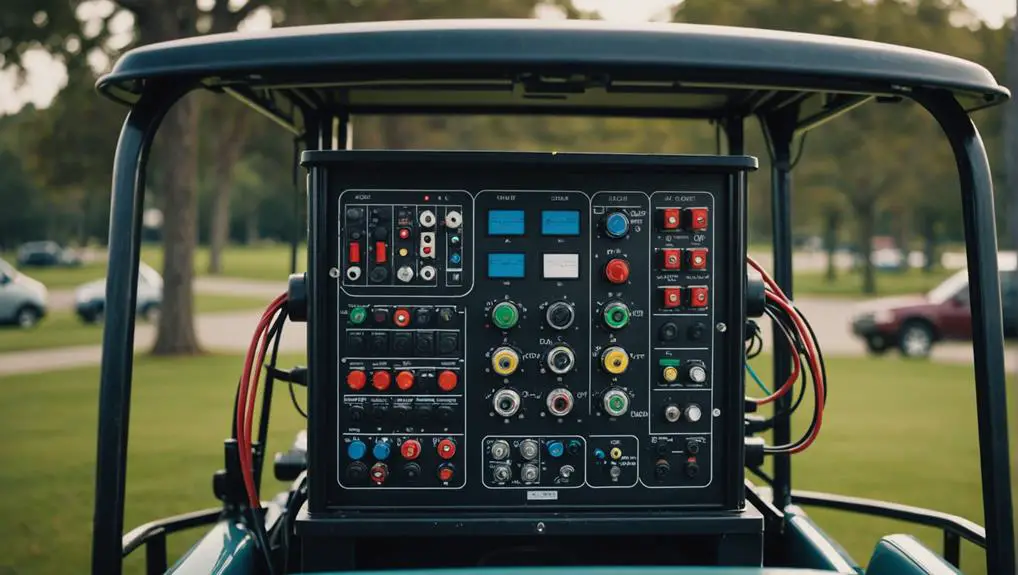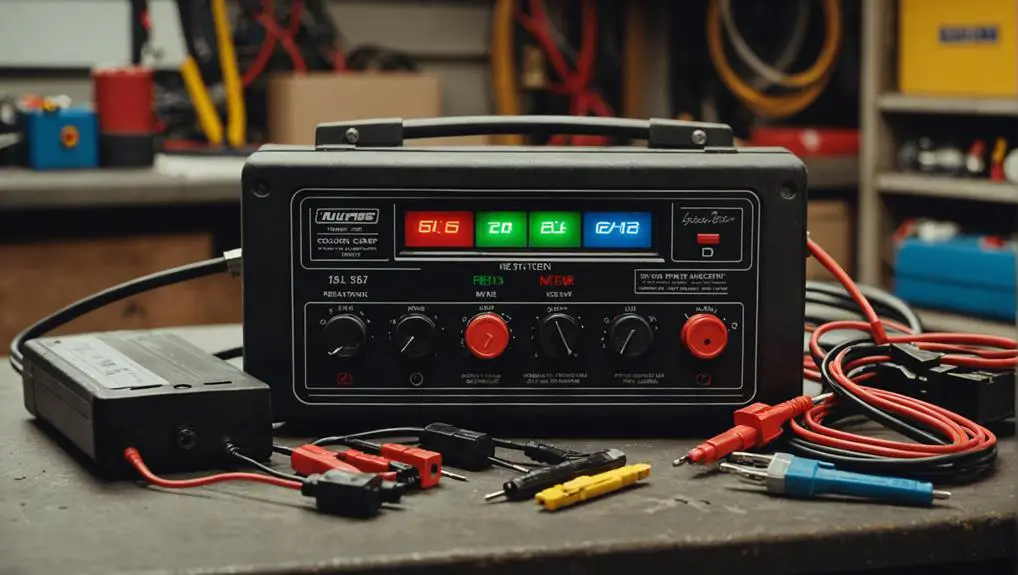Most people don't realize that understanding a Club Car battery wiring diagram can greatly enhance your maintenance skills. You might think it's just a jumble of lines and colors, but it actually reveals critical information about how your vehicle's electrical system functions. By grasping the basics of wiring diagrams, you can troubleshoot issues more effectively and guarantee your Club Car runs smoothly. So, what are the key components and symbols you should look out for? Let's explore that further to equip you with the knowledge you need.
Key Takeaways
- Identify the power source and follow the lines to trace current flow through the circuit in the diagram.
- Understand symbols like battery representations, wires, and junctions to interpret connections and components correctly.
- Use wire color codes (red for positive, black for negative) to determine specific functions of the wires.
- Check for series and parallel connections to assess how components interact within the circuit.
- Look for breaks or anomalies in the paths to diagnose potential issues and ensure continuity.
Understanding Battery Basics
When you immerse yourself in understanding battery basics, it's essential to grasp how batteries function in your Club Car. Batteries store electrical energy through chemical reactions, allowing your vehicle to operate efficiently. The two main types you'll encounter are lead-acid and lithium-ion batteries. Lead-acid batteries are more common in older models, while lithium-ion batteries are increasingly found in newer models due to their lightweight and longer lifespan.
Each battery consists of cells that produce voltage through electrochemical reactions. In a 36-volt Club Car, for instance, you'll typically find six 6-volt batteries connected in series. This configuration guarantees that voltage adds up, providing the necessary power for your vehicle.
Understanding amp-hours (Ah) is also important; it measures the battery's capacity to deliver current over time. A higher Ah rating means longer run times, which is critical for your outings.
Additionally, pay attention to the state of charge (SOC) and the depth of discharge (DOD). Maintaining proper SOC and DOD helps prolong battery life and guarantees peak performance.
Familiarizing With Wiring Diagrams
Familiarizing yourself with wiring diagrams is vital for troubleshooting and maintaining your Club Car's electrical system. These diagrams serve as a roadmap, illustrating how components connect and interact.
Begin by locating the specific diagram for your model, as different models may have unique configurations. Pay attention to the layout; wiring diagrams typically display components like batteries, controllers, and motors in a clear, organized manner.
You'll notice that lines represent wires, while junctions indicate connection points. Understanding these connections is essential for diagnosing issues like short circuits or faulty batteries.
Next, identify the flow of electricity. The diagram usually illustrates the power source, often the battery, and shows how electricity travels through the system. This knowledge helps you pinpoint where issues may arise.
Lastly, take note of any color coding and labels. These elements provide critical information about wire functions and specifications.
Key Symbols and Terminology

Understanding the key symbols and terminology in wiring diagrams is fundamental to effectively interpreting them. Each diagram uses specific symbols to represent components, connections, and functions, making it essential for you to familiarize yourself with them.
Common symbols include the battery symbol, which typically looks like two parallel lines, representing the positive and negative terminals. The wire is usually depicted as a straight line, while connections are indicated by dots at junctions. Switches are shown as a break in the line, often accompanied by an additional symbol to denote the switch type, like a toggle or push-button.
You'll also encounter symbols for fuses, resistors, and circuit breakers. Each plays a significant role in circuit protection and functionality.
Terminology like "voltage," "current," and "ground" is important as well; understanding these terms helps you grasp the overall circuit operation.
Familiarity with this lexicon not only aids in reading diagrams but also enhances your troubleshooting skills. By mastering these symbols and terms, you'll guarantee you're better equipped to interpret the wiring diagrams accurately and make informed decisions during repairs or modifications.
Identifying Wires and Connections
When identifying wires and connections in a Club Car battery wiring diagram, you'll want to focus on wire color codes as they indicate specific functions.
Pay attention to terminal locations, which help you understand where each wire connects.
Familiarizing yourself with common connection types will further streamline your wiring process.
Wire Color Codes
Deciphering wire color codes is essential for effectively reading a Club Car battery wiring diagram. Each color serves a specific purpose, helping you identify the function of the wires in the system. Typically, red wires indicate positive connections, while black wires signify negative. Understanding this basic color coding allows you to make quick assessments of the wiring layout.
You'll often encounter other colors as well. For example, yellow and green wires are commonly used for ground connections, while blue and white wires might serve as auxiliary connections for lights or other accessories.
If you see a wire that's striped, it typically indicates a combined function or a specific signal, so pay attention to those patterns.
In some cases, manufacturers may use variations of these standard codes, so always refer to the specific wiring diagram for your model. If you're ever in doubt, consult the vehicle's service manual or a professional for clarification.
Terminal Locations Explained
Terminal locations play an essential role in identifying wires and connections within a Club Car battery system. Each terminal on the battery is designated for specific functions, making it vital for you to understand their arrangement.
Generally, you'll find positive (+) terminals marked with red or a "+" symbol, while negative (-) terminals are marked with black or a "-" symbol.
When you're examining the wiring diagram, focus on the terminal layout. Note that the positive terminal connects to various components such as the solenoid and ignition system, ensuring the flow of current.
The negative terminal typically connects to the chassis ground, completing the circuit.
To accurately trace connections, identify the wires corresponding to each terminal. Wires may vary in color and gauge, and their placement indicates their function.
For instance, thicker wires typically handle higher currents, while thinner wires may be for sensors or control circuits.
Common Connection Types
Understanding the common connection types is key to effectively interpreting a Club Car battery wiring diagram. You'll encounter several wire types, each serving specific purposes. The most common are positive (red) and negative (black) wires. The positive wire carries current from the battery to the components, while the negative wire completes the circuit back to the battery.
You'll also see battery terminals, which are typically labeled as "B+" for positive and "B-" for negative. Make sure to identify these correctly, as reversing connections can damage the system.
Ring terminals are often used to connect wires securely to battery posts. These offer a reliable connection and are less likely to loosen over time.
Inline connectors may appear, allowing for easy disconnections for maintenance or replacement. Look for bullet connectors or spade connectors; they facilitate quick connections without tools.
Reading Circuit Paths

Reading circuit paths in a Club Car battery wiring diagram is vital for troubleshooting and maintenance. To effectively interpret these diagrams, start by identifying the power source, typically the battery. Follow the lines that represent electrical connections; these lines indicate the flow of current throughout the system.
Next, observe the symbols representing components like switches, fuses, and motors. Each symbol corresponds to a specific function within the circuit. For instance, a switch may open or close the circuit, while a fuse protects against overcurrent.
Pay attention to the junctions where lines intersect; these points often indicate connections between different circuit paths. Make certain you understand whether these connections are series or parallel, as this affects how the components interact and function together.
When tracing a circuit path, note any breaks or discontinuities, as these can signify potential issues. It's imperative to follow the circuit path from start to finish, confirming the intended route of current flow.
Analyzing Voltage and Amperage
When analyzing voltage and amperage in a Club Car battery wiring diagram, you're focusing on the vital electrical characteristics that dictate how the system operates. Understanding these parameters is essential for guaranteeing peak performance and safety.
Voltage, measured in volts (V), represents the electrical potential difference between two points. In your diagram, note the voltage ratings of the batteries and components. Verify they align with the specifications of your Club Car, as mismatched voltages can lead to inefficient operation or damage.
Amperage, or current, is measured in amperes (A) and indicates the flow of electricity through the circuit. Check the wiring gauge specified in the diagram; a lower gauge number denotes thicker wire capable of handling higher current loads. If the amperage exceeds the wire's capacity, it can overheat and cause failures.
Pay attention to connections, especially in series and parallel configurations, as these affect both voltage and amperage throughout the circuit.
Troubleshooting Common Issues

Troubleshooting common issues in a Club Car battery system often involves identifying specific problems that can disrupt performance. Start by checking for loose or corroded connections. Corrosion can impede electrical flow, so clean terminals and secure connections as needed.
If the cart isn't charging, examine the charger and verify it's functioning properly. Test the output voltage and confirm that it matches the specifications.
Next, look for signs of battery wear or damage. Check for swelling, leaks, or unusual heat during operation. If you notice any of these, it might be time to replace the battery.
Additionally, measure the individual battery voltages within the pack. A significant voltage drop in one battery can indicate a failure, affecting overall performance.
If the cart runs but lacks power, consider testing the motor and controller for issues. Inspect wiring for damage or short circuits, which can lead to performance drops.
Safety Precautions to Consider
Before you start working on the battery wiring diagram, make certain to wear protective gear to safeguard against accidents.
Always disconnect the power source to prevent any electrical shocks.
Additionally, using the proper tools guarantees a safe and efficient process.
Wear Protective Gear
Wearing appropriate protective gear is essential for anyone working with a Club Car battery wiring diagram. When dealing with batteries, you expose yourself to potential hazards, including acid spills and electrical shocks.
Start with safety goggles to protect your eyes from splashes or debris. Opt for gloves made from rubber or nitrile to shield your hands from corrosive materials.
A lab coat or heavy-duty work shirt can help protect your skin from accidental contact with battery acid. Always wear closed-toe shoes with slip-resistant soles to guarantee stability and protection from heavy objects.
If you're working in a poorly ventilated area, consider using a mask to prevent inhaling harmful fumes. In addition, make certain that your work area is well-lit, as good visibility reduces the chances of accidents.
Avoid wearing loose clothing or accessories that could get caught in machinery. Finally, keep a first-aid kit nearby in case of an emergency.
Disconnect Power Source
Disconnecting the power source is an essential step in safely working with your Club Car battery wiring diagram. Before you begin any wiring tasks, verify that the power is completely turned off. This minimizes the risk of electric shock and prevents potential damage to the vehicle's electrical components.
Always start by removing the negative terminal from the battery, followed by the positive terminal. This order is significant; it helps avoid short circuits during disconnection.
Make certain to use insulated tools when working on the battery terminals. This adds an extra layer of safety, protecting both you and the vehicle. Avoid touching any exposed wires or terminals during this process, as they may carry residual voltage. If you're unsure about the disconnection procedure, refer to the manufacturer's guidelines for your specific model.
Once the power source is disconnected, double-check that all connections are secure and that there's no chance of accidental reconnection.
Use Proper Tools
Using the right tools is fundamental when working with a Club Car battery wiring diagram. First, gather a multimeter to measure voltage and continuity in the circuit. This tool will help you troubleshoot any issues you encounter.
A wire stripper is essential for preparing wires for connections, guaranteeing clean and effective contact. Additionally, a set of pliers can assist in gripping and manipulating wires safely.
You'll also want to have a screwdriver set on hand for removing and securing battery terminals and other components. Make sure you have a socket wrench for any bolts that may need loosening or tightening.
Don't forget electrical tape or heat shrink tubing for insulating connections and preventing shorts. While these tools are important, safety gear is equally significant. Wear safety goggles to protect your eyes from potential sparks or debris. Gloves can prevent accidental shocks and protect your hands from sharp edges.
Lastly, keep a flashlight available for illuminating dark spaces around the battery and wiring. By using the proper tools and safety precautions, you'll make your work with the Club Car battery wiring diagram more efficient and secure.
Practical Tips for Maintenance

Regular maintenance is essential for keeping your Club Car battery in ideal condition. By following these practical tips, you can enhance the lifespan and performance of your battery:
- Check Fluid Levels: Verify the electrolyte levels are adequate. If they're low, top them off with distilled water, but don't overfill. This helps prevent sulfation and overheating.
- Clean Terminals: Inspect battery terminals for corrosion. Use a mixture of baking soda and water to clean them, ensuring a good connection. A clean terminal helps in maintaining efficient power flow.
- Monitor Charge: Regularly check the battery's charge level using a voltmeter. Ideally, you want to maintain a charge of around 50% or more.
Avoid deep discharges as they can markedly reduce battery life.
Frequently Asked Questions
What Tools Do I Need to Read a Wiring Diagram Effectively?
To read a wiring diagram effectively, you'll need a few essential tools.
First, grab a good multimeter to measure voltage and continuity. A quality wire stripper helps you prepare wires for connections.
Use a magnifying glass for reading small print. A notepad and pen are handy for jotting down notes or drawing connections.
Can I Use a Multimeter With the Wiring Diagram?
Yes, you can use a multimeter with a wiring diagram. It helps you measure voltage, continuity, and resistance, ensuring that connections are functioning correctly.
Start by identifying the points in the diagram where you'll test. Set your multimeter to the appropriate setting, and connect the probes to the corresponding terminals.
This way, you can accurately diagnose issues and confirm that everything's wired correctly, making your troubleshooting more efficient and effective.
How Do I Interpret Color Codes on Wiring Diagrams?
To interpret color codes on wiring diagrams, start by familiarizing yourself with standard conventions. Typically, red signifies positive connections, black indicates negative, and other colors represent specific functions like ground or signal.
Check the diagram's legend for unique codes. When tracing wires, guarantee you match the colors to their respective components accurately.
This attention to detail helps you avoid mistakes and guarantees proper functionality in your electrical systems.
Where Can I Find Specific Diagrams for Older Club Car Models?
Like a treasure map guiding you through uncharted territory, specific diagrams for older Club Car models can be found in various places.
Start with the manufacturer's website, where archived resources often reside. Online forums and enthusiast groups are gold mines, as members frequently share diagrams.
Additionally, consider purchasing a service manual tailored to your model, ensuring you've got accurate and detailed information at your fingertips for your maintenance and repair needs.
Is It Necessary to Disconnect the Battery Before Reading the Diagram?
Yes, it's necessary to disconnect the battery before reading the wiring diagram.
Doing so guarantees your safety and prevents any accidental short circuits while you work. When the battery's connected, you risk electrical shock or damaging components.
Disconnecting the battery allows you to inspect the wiring without the worry of live connections.
Always prioritize safety by taking this precaution before diving into any electrical work.
Conclusion
By mastering the art of reading a Club Car battery wiring diagram, you're not just gaining knowledge; you're revealing the secret to electrical wizardry! With each color-coded wire and symbol, you'll become a troubleshooting superhero, zapping away issues with ease. You'll navigate circuit paths like a pro, ensuring your ride runs smoother than a freshly oiled machine. So, gear up and plunge into the electrifying world of wiring diagrams—your Club Car's performance will thank you!